The EEGLAB News #9
Stefan Debener, Ph.D.
Chair, Department of Psychology,
Head of the Neuropsychology Lab,
University of Oldenburg, Germany
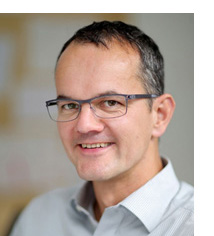
“I measure my success in how well the people leaving my lab can advance their careers,” shares Dr. Stefan Debener, Chair in Psychology and head of the Neuropsychology Lab at the University of Oldenburg, Germany. “Given the current situation with COVID-19,” he adds, “there are not too many options. I have the great pleasure of working with many highly talented students and post-doctoral fellows, and I just hope they will get along well enough.”
Dr. Debener is a prolific researcher who studies higher visual, auditory, and motor functions using mobile EEG technology, as well as clinical neuropsychology and neurorehabilitation. He has helped develop the first commercially available ear EEG sensor, as well as several EEGLAB plug-ins, and has organized many EEGLAB workshops. But in addition to these accomplishments, he considers his job as mentor to be important.
Perhaps this core belief is influenced by his gratitude for the help he received on his own path. As postdoctoral fellow in 2002, Dr. Debener met Dr. Scott Makeig at the Donders Center in Nijmegen, Netherlands. Mesmerized by Dr. Makeig’s vision of the potential of the electroencephalogram (EEG), he requested an internship at the Swartz Center for Computational Neuroscience (SCCN), and gratefully began his position there in 2003. “Getting to know Scott was as important for my career as getting to know EEGLAB,” Dr. Debener admits candidly. “Arno Delorme and Julie Onton helped me get up and running with EEGLAB. I am still grateful for their support to this very day. Back home, I organized many EEGLAB workshops in Germany and abroad and got to know many researchers in the field, which helped me advance my career.”
Path to the Neuropsychology Lab. Dr. Debener grew up in the countryside, in the most western part of West Germany, close to the Dutch border. His first experience with EEG as a psychology undergraduate at the Berlin University of Technology in Germany (1989) was very different from the technology of today: “I got the opportunity to play with a monstrous 4-channel analog EEG machine that was the size of a wardrobe and featured a paper plotter and an oscilloscope that was so worn out that one could hardly see any traces. There was no manual and no one really knew how to operate the machinery and what all those buttons and knobs would do, but funny traces came out and so I got lost in EEG research.”
 His fascination with EEG has continued ever since. Dr. Debener received his Ph.D. in Psychology from the Technical University of Dresden (2001), and after a post-doc and various positions in the field, he landed a role as Professor at the University of Oldenburg, where he became Head of the Neuropsychology Lab. (Photo: Lab members, Credit: Neuropsychology Lab).
His fascination with EEG has continued ever since. Dr. Debener received his Ph.D. in Psychology from the Technical University of Dresden (2001), and after a post-doc and various positions in the field, he landed a role as Professor at the University of Oldenburg, where he became Head of the Neuropsychology Lab. (Photo: Lab members, Credit: Neuropsychology Lab).
“My personal goal,” Dr. Debener reveals, “is to further our understanding of the brain-behavior relationship. How does the brain respond to sensory deprivation, and how could a better knowledge of compensatory mechanisms help us to improve rehabilitation strategies, for instance in the deaf? How does information from the different senses, such as seeing and hearing, combine to create a coherent perception of the world? Why do we make errors even in very simple tasks? And could we predict those errors before they occur?”
 Mobile EEG Technology. To study these questions, Dr. Debener realized the need for technology that could record brain activity while participants were engaged in daily-life activities, outside the controlled conditions of the laboratory. At the time of that realization ten years ago, “hardly anyone considered studying brain-electrical activity in truly mobile, non-stationary conditions, so recording EEG while freely walking outdoors became a challenge we wanted to master.”
Mobile EEG Technology. To study these questions, Dr. Debener realized the need for technology that could record brain activity while participants were engaged in daily-life activities, outside the controlled conditions of the laboratory. At the time of that realization ten years ago, “hardly anyone considered studying brain-electrical activity in truly mobile, non-stationary conditions, so recording EEG while freely walking outdoors became a challenge we wanted to master.”
To this end, Dr. Debener and his team developed a small, wireless, lightweight and fully head-mounted electroencephalography (EEG) system by working with consumer devices. Their first mobile EEG paper (2012) was well received, and several other groups could replicate their findings. From there, Dr. Debener and his team set their sights on developing portable and wearable brain technologies for neuroenhancement and neurorehabilitation. “Mobile technology enables us to not only study behavior under realistic conditions,” Dr. Debener explains, “but it is also an important step towards mobile Brain-Computer-Interfaces (BCIs) or neurofeedback applications for neurorehabilitation.”
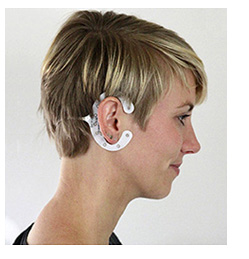 But they encountered a hurdle – the EEG electrode cap potentially compromised daily-life applications. “We wanted to ensure that the electrodes on the head were less visible and were comfortable to wear for many hours,” Dr. Debener explains. To tackle this issue, the team explored the idea of creating miniaturized EEG electrodes. “By placing mini EEG electrodes at unusual locations, such as the outer ear canal,” Dr. Debener surmised, “it may be possible to develop a near-invisible EEG acquisition, thereby improving the practicability of a Mobile Brain-Computer Interface (BCI)."
But they encountered a hurdle – the EEG electrode cap potentially compromised daily-life applications. “We wanted to ensure that the electrodes on the head were less visible and were comfortable to wear for many hours,” Dr. Debener explains. To tackle this issue, the team explored the idea of creating miniaturized EEG electrodes. “By placing mini EEG electrodes at unusual locations, such as the outer ear canal,” Dr. Debener surmised, “it may be possible to develop a near-invisible EEG acquisition, thereby improving the practicability of a Mobile Brain-Computer Interface (BCI)."
Thus was born the cEEGrids - the first commercially available ear EEG sensor (Debener et al., 2015). “The cEEGrids are flex-printed EEG sensors,” Dr. Debener explains enthusiastically. “Wires, electrodes and connectors are printed with sliver ink on a flexible material.” (Photo: cEEGrids; Credit: Neuropsychology Lab)
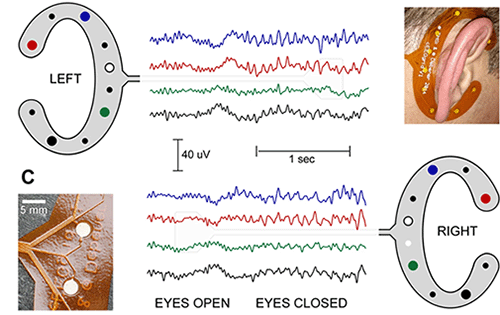 Development took Dr. Debener’s team a few years, and the lab is excited to now see the devices being used successfully in other labs. “Flex-printed sensors haveseveral advantages.” Dr. Debener clarifies, “For instance, they enable low electrode impedance for many hours, and in many cases, users even forget they are wearing them.”
Development took Dr. Debener’s team a few years, and the lab is excited to now see the devices being used successfully in other labs. “Flex-printed sensors haveseveral advantages.” Dr. Debener clarifies, “For instance, they enable low electrode impedance for many hours, and in many cases, users even forget they are wearing them.”
Dr. Debener and his research team use mobile EEG technology on several new projects – for example, in an upcoming motor-cognitive interference study in patients with Parkinson's Disease. In another, they are studying EEG correlates of auditory attention in every-day life. Dr. Debener hopes that their findings will shed light on neural mechanisms involved in selective auditory attention in every-day situations, to ultimately be used to improve hearing aid algorithms and make listening more pleasant for hearing aid users. (Image: Illustration of the cEEGrid design and layout. Credit: Neuropsychology Lab)
Software Solutions. While mobile EEG has proven extremely beneficial, the technology comes with its challenges: “Signal quality depends a lot on hardware details. Usability is far from perfect, as well,” he admits candidly. “And we need to integrate information from various sensors, like GPS, audio, IMUs etc.” To address these issues, members of the Neuropsychology lab are also hard at work, developing software solutions.
One such solution is the time-synchronized streaming of EEG and smartphone sensors on Android using the software application SCALA (Signal ProCessing and CLassification on Android, freely available on Github). “Our time-synchronized streaming and recording on smartphone(s) apps will be released very soon,” Dr. Debener shares eagerly. “We are about to submit the reference paper for publication. We heavily rely on the wonderful LabStreamingLayer (LSL) framework developed by Christian Kothe and other SCCN members (LSL is one of the most remarkable achievements of SCCN, in my opinion), and try to develop tools to better use LSL on Android. This package here, for instance, allows closed-loop EEG processing (i.e. BCI) on a smartphone.”
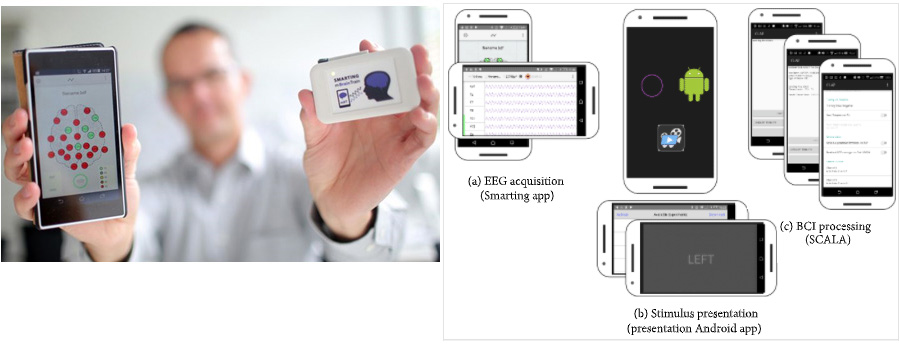
Left: One of the first reliably working mobile EEG systems, recording wireless signals on Android smartphones – 24ch Smarting system from the company mBrainTrain, Serbia; Credit: University of Oldenburg. Right:The multiapp BCI on Android approach. An EEG data acquisition application (a) and a stimulus presentation application (b) communicate with our BCI signal processing application SCALA (c). All three applications run on the smartphone during an experiment. They exchange data using socket-based, synchronized communication. Credit: Neuropsychology Lab).
EEGLAB. Dr. Debener relies on several key tools for his research, including the high-density EEG, functional magnetic resonance imaging (fMRI), near infrared spectroscopy (NIRS), and magnetoencephalography (MEG). “Because these tools provide us with very complex, mixed signals that reflect different features of human brain function,” he elucidates, “we spend some time on the application and evaluation of signal un-mixing and signal integration procedures as well.”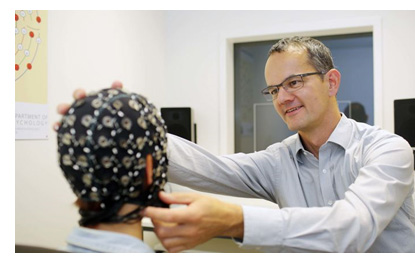
EEGLAB is integral to this effort. “EEGLAB is our workhorse and primary choice. There is hardly any paper we publish that has not EEGLAB under the hood. I like how well the data are structured in the EEGLAB framework and believe that EEGLAB is a great gateway towards Matlab programming for those without a formal education in programming.” He continues, “For many years, EEGLAB has been our key tool for data cleaning and preprocessing and there are great developments going on, like integration to Brain Imaging Data Structure (BIDS) or running EEGLAB on nsgportal. (Photo credit: Neuropsychology Lab)
His team has developed several EEGLAB plug-ins over the past few years:
- CORRMAP (a semi-automatic artifact independent component clustering tool that was popular for a while and may have inspired the development of current state of the art solutions, like FASTER, ADJUST, ICLabel etc.);
- CIAC (a semi-automatic plug-in to identify independent components representing electrical artifact in EEG recordings from cochlear implant users);
- cEEGridplugin, a plug-in to visualize cEEGrid ear EEG data; and
- rASR, a variant of ASR which is now an option in the official CleanRawData plug-in.
And recently, the team published a paper on how to interact with Brainstorm, a toolbox that complements EEGLAB.
Because Dr. Debener believes strongly in EEGLAB, he has taken an active role in organizing EEGLAB workshops, from the very beginning: “I was happy to help Scott and Arno on the first EEGLAB workshop, held in San Diego (2004), and the Second EEGLAB workshop, held in Porto, Portugal (2005).” There have been many since.
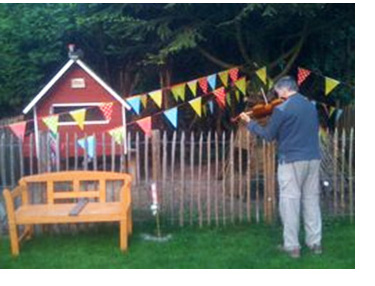 These EEGLAB experiences have provided Dr. Debener fond memories, both professional and personal. He recollects vividly, for instance, the time “after a rewarding winter EEGLAB workshop in a very remote part of Poland, we ended up taking a sleigh ride in the snow at night, protected against the cold with heavy fur blankets, [warm drinks] and by singing popular German and Poland tunes!” He also recalls some personal moments, such as the time in his garden in Oldenburg “when Dr. Makeig played folk tunes on his fiddle - to my chickens! I will never forget this beautiful moment (even our cock fell silent for a moment)!” (photo to right) He lingers on that memory, then continues, “I also remember Scott playing the grand piano in Delmenhorst during a workshop, accompanying Maarten De Vos on the violin.”
These EEGLAB experiences have provided Dr. Debener fond memories, both professional and personal. He recollects vividly, for instance, the time “after a rewarding winter EEGLAB workshop in a very remote part of Poland, we ended up taking a sleigh ride in the snow at night, protected against the cold with heavy fur blankets, [warm drinks] and by singing popular German and Poland tunes!” He also recalls some personal moments, such as the time in his garden in Oldenburg “when Dr. Makeig played folk tunes on his fiddle - to my chickens! I will never forget this beautiful moment (even our cock fell silent for a moment)!” (photo to right) He lingers on that memory, then continues, “I also remember Scott playing the grand piano in Delmenhorst during a workshop, accompanying Maarten De Vos on the violin.”
Worldwide Efforts.
Dr. Debener has become a world traveler, visiting EEG labs in Austria, Switzerland, Canada, Pakistan, the United Kingdom, Singapore, Netherlands, Norway, and all over Germany. Recently, he expanded this role by helping to establish a research EEG laboratory in Pakistan. After a student from Islamabad, Maryam Saeed, visited his lab for EEG training, she invited him to give an EEGLAB workshop at her home university, NUST School of Electrical Engineering and Computer Science. “I was impressed by the excellent education of many Pakistani students,” he recalls, “but they had no good access to a research lab and therefore mainly worked on data repositories. However, I truly believe that hands-on training in EEG acquisition is essential to get the most out of your data.” So, he convinced the Dean, Dr. Zaidi, to provide a room, and several companies (Brain Products, EASYCAP and mBrainTrain) to donate EEG hardware. And in 2018, a new EEG lab was born.
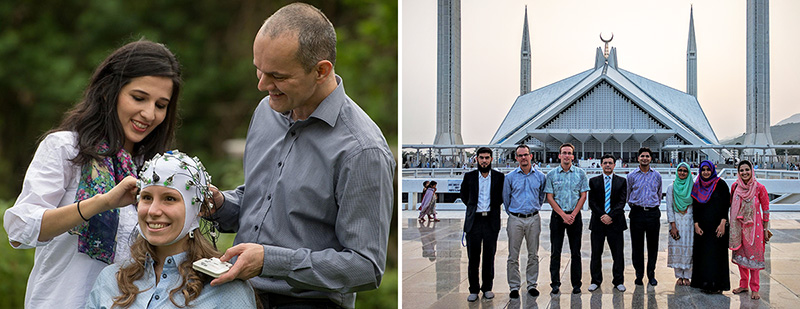
Prof. Debener (2nd from left), Prof. De Vos (3rd from left), and Dr. Kamboh (left) and his Neuroinformatics Group in Islamabad, Pakistan (Credit: S. Debener).
The Future.
Gauging by his adventurous career path, it seems clear that Dr. Debener enjoys exploring new research areas. When asked about his future, he responds: “I want to be as open-minded as possible. I love that my position allows me to work on whatever topic I might get interested in. Every ten years or so a new idea pops up and keeps me busy for years. But I don't want to spend my whole life on a single topic.” Fittingly, when asked which of his publications he would like to highlight, he answered, “The next!”
While Dr. Debener relishes the freedom of discovery, his students and colleagues seem foremost on his mind. Reflecting on the deep challenges of this pandemic year, he pauses, then concludes, “I just hope that the many wonderful individuals I have gotten to know during my career are safe.”
R. Weistrop, July 2021
_______________________